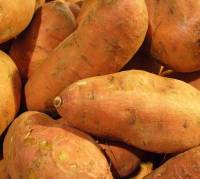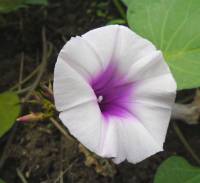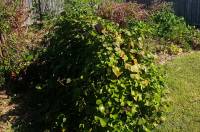This is an old revision of the document!
Sweet Potato
Botanical Information
| Botanical Information | |
|---|---|
| Order | Solanales |
| Family | Covlvulaceae |
| Genus | Impomea |
| Common Name | Sweet Potato |
| Species | |
Maturity days
- 90
Planting Months
| Planting months | |||||||||||
|---|---|---|---|---|---|---|---|---|---|---|---|
| Jan | Feb | Mar | Apr | May | Jun | Jul | Aug | Sep | Oct | Nov | Dec |
| X | X | X | X | X | X | X | X | X | X | X | X |
Permaculture uses
| Permaculture uses | ||
|---|---|---|
| Usage 1 | Usage 2 | Usage 3 |
| Pioneer | Ground_cover | Vegetable |
Growing condition comments
| Growing Condition | Comment |
|---|---|
| Drought Tolerant | |
| Humidity tolerant | Yes |
| Planting area | Garden_bed |
| Sunlight | Full_sun |
Photos
Short comments
Scrambling vine. Edible leaves like spinnach. Can be trained onto a trelis. Grow tubers in deep as possible, to restrict the ability for the sweet potato weevil to damage the tubers.
General comments
Ecology
Best planted in separate beds. Require long warm growing season. Plant in free draining soil. Fertilise before planting, too much fertiliser will encourage vine growth rather than tuber growth.
Dry harvested tubers in sun for a couple of days following harvesting, then store in a cool dry place.
Companion plant with Cowpea.
Uses
Ground cover, edible.
Food
Use mashed, boiled, roasted, baked or fried. Or use in soups, pies, casseroles, curries and salads. Leaves are edible and are cooked like spinach.
Planting Depth
Harder soil with a mulch layer will promote fatter tubers, whereas friable soil can promote longer and skinnier tubers.
Growth from supermarket
Sweet potato's can be grown from tubers purchased from the supermarket. Beware that this can introduce disease into your garden.
- Wash the potato
- Leave in cupboard to sprout
- Plant
Alternatively, you can cut the tuber into 25mm chunks, allow the sides to dry and then place in a saucer of water to promote growth, watch for mold and change the water as necessary.
Pests
The most serious pest is the sweet potato weevil. These pests will damage tubers if they are exposed to the surface, they burrow through the tubers which spoil them. Tubers are best planted deeper and kept hidden from the surface to prevent weevil damage. Damage looks like lots of tiny holes bitten out of the exposed tubers. Not all surface damaged tubers will contain the weevils but the risks of internal damage do increase.
Ants if they are near by will attack the weevils. If this pest is detected, it is best that future crops are moved elsewhere rather than being replanted in the same spot.


